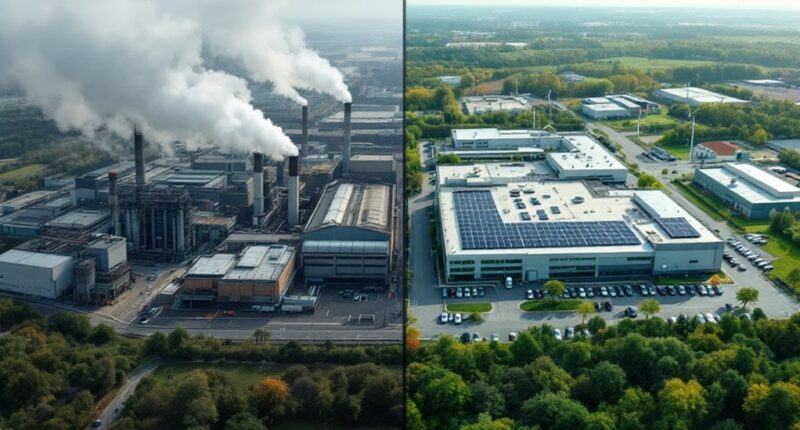Corporate carbon neutrality represents a strategic business approach that balances emissions with equivalent removals. Companies typically begin with thorough carbon audits, then implement energy efficiency measures, switch to renewables, optimize processes, and invest in carbon offsets. While challenges exist in measurement and avoiding greenwashing, benefits include enhanced reputation, cost savings, and better positioning for regulations. The journey to net-zero isn’t just environmentally virtuous—it’s increasingly becoming a financial imperative in today’s climate-conscious marketplace. The roadmap continues beyond neutrality into sustainable innovation.

In today’s climate-conscious business landscape, corporate carbon neutrality stands as the Mount Everest of sustainability goals—challenging to reach but impossible to ignore. Companies worldwide are realizing that balancing their carbon books isn’t just environmental virtue signaling; it’s becoming a business imperative that separates tomorrow’s survivors from yesterday’s dinosaurs.
Corporate carbon neutrality involves a delicate balancing act—emitting carbon while simultaneously removing an equivalent amount from the atmosphere. It’s like maintaining a perfect caloric balance, except instead of counting cookies, you’re tracking emissions across all three scopes: direct operations, purchased energy, and that notorious tangle of supply chain complications. Unlike “zero carbon” (the environmental equivalent of never touching carbs), neutrality acknowledges that some emissions are unavoidable—but compensable.
Carbon neutrality: the corporate world’s perfect scale where every emission has its redemption story.
The path to neutrality begins with an in-depth carbon audit—essentially a weigh-in for your corporate carbon waistline. Companies then implement a diet of energy efficiency measures, switch to renewable energy (solar panels: the kale of the energy world), and optimize processes to minimize waste. For those stubborn remaining emissions that just won’t budge (we all have trouble spots), carbon offset investments serve as the corporate equivalent of makeup to cover environmental blemishes. Leading businesses such as Microsoft, Unilever, and Apple have demonstrated how carbon neutrality measures can be successfully integrated into corporate strategy.
Benefits extend beyond feeling environmentally virtuous. Carbon-neutral companies enjoy enhanced brand reputation, reduced energy costs, and access to increasingly available green financing options. The adoption of clean technologies throughout operations significantly reduces long-term environmental impact while maintaining productivity. They’re also better positioned to weather the incoming storm of regulations that governments are cooking up faster than a microwave dinner.
Challenges abound, however. Measuring emissions remains as standardized as teenage fashion trends, particularly when dealing with sprawling supply chains. Companies also risk accusations of greenwashing if their claims outpace their actions—the corporate equivalent of posting gym selfies while eating donuts.
Financial opportunities make the journey worthwhile. Energy efficiency measures often pay for themselves faster than expected, while green financing options multiply like rabbits in springtime. As investors increasingly scrutinize ESG performance, carbon neutrality isn’t just good citizenship—it’s good business.
Frequently Asked Questions
How Much Does Carbon Neutrality Certification Typically Cost?
Carbon neutrality certification costs vary substantially. Small businesses typically pay $750-$880 minimum, while larger corporations may spend $2,000+ annually. Nonprofits often qualify for 50% discounts.
The total investment extends beyond certification fees—carbon footprint software costs ($2,000-$5,000/year), third-party verification fees ($5,000-$50,000), and carbon offset purchases ($5-$20 per metric ton of CO2) contribute to the overall expense. Costs also depend on the industry sector, geographic location, and the complexity of emissions measurement.
Can Small Businesses Feasibly Achieve Carbon Neutrality?
Small businesses can feasibly achieve carbon neutrality, though challenges exist. While 60% of SMEs plan to reduce their carbon impact, barriers include knowledge gaps (63%), funding limitations (48%), and time constraints (40%).
The path to success includes implementing energy-efficient practices (saving 10-25% on costs), investing in renewables, and utilizing resources like the SME Climate Hub. External funding remains vital, as 70% of SMEs need financial support to accelerate their emissions reduction journey.
What Penalties Exist for Missing Carbon Reduction Targets?
Companies missing carbon reduction targets face varying consequences. While regulatory penalties are emerging—like NYC’s $1000/day non-compliance fines or the UK’s potential 10% of turnover for greenwashing—most face limited accountability.
Surprisingly, 31% of companies with missed 2020 targets simply stopped reporting progress. The real penalties often manifest as reputational damage: lost environmentally-conscious customers, diminished investor confidence, talent recruitment challenges, and increased public scrutiny rather than direct financial penalties.
How Do Carbon Offset Quality Standards Compare Globally?
Global carbon offset standards vary in focus and market share, with Verra’s VCS dominating (68.5% of credits issued), followed by Gold Standard (20.1%). Each standard employs different approaches to key quality criteria like additionality, permanence, and verification protocols.
Emerging frameworks such as the Core Carbon Principles aim to harmonize standards, while the market increasingly values removals over avoidance credits. The challenge remains balancing rigorous scientific accounting with practical implementation across diverse project types and geographies.
Will Carbon Neutral Status Affect Customer Purchasing Decisions?
Carbon neutral status substantially impacts purchasing decisions, with 87% of Americans favoring products with carbon-neutral labels. Research shows consumers perceive these products as more sustainable, healthier, and of higher quality—a phenomenon known as the “green halo effect.”
With 80% of consumers willing to pay premiums averaging 9.7% for sustainable products, companies embracing carbon neutrality enjoy a competitive advantage. This trend is particularly strong among Millennials, where 75% consider climate impact when shopping.









